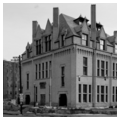You are here
Johnstown Flood Museum (Johnstown Carnegie Library)
As a member of the South Fork Fishing and Hunting Club, which was partially responsible for the maintenance and subsequent failure of the South Fork dam, Andrew Carnegie funded this library in 1890 after touring the disaster area in 1889. Architect Addison Hutton (1834–1916), a Westmoreland County native and Quaker, trained under and, for a time, shared a practice with Samuel Sloan in Philadelphia. The three-story tan brick Chateauesque building has been refitted as the Johnstown Flood Museum. The steeply pitched roofline, intricate gabled dormers, and tall narrow chimneys give the building an elegance beyond the grammar of its plaque that states: “Rebuilded, Enlarged & Improved by ANDREW CARNEGIE, 1891.”
Writing Credits
If SAH Archipedia has been useful to you, please consider supporting it.
SAH Archipedia tells the story of the United States through its buildings, landscapes, and cities. This freely available resource empowers the public with authoritative knowledge that deepens their understanding and appreciation of the built environment. But the Society of Architectural Historians, which created SAH Archipedia with University of Virginia Press, needs your support to maintain the high-caliber research, writing, photography, cartography, editing, design, and programming that make SAH Archipedia a trusted online resource available to all who value the history of place, heritage tourism, and learning.


















